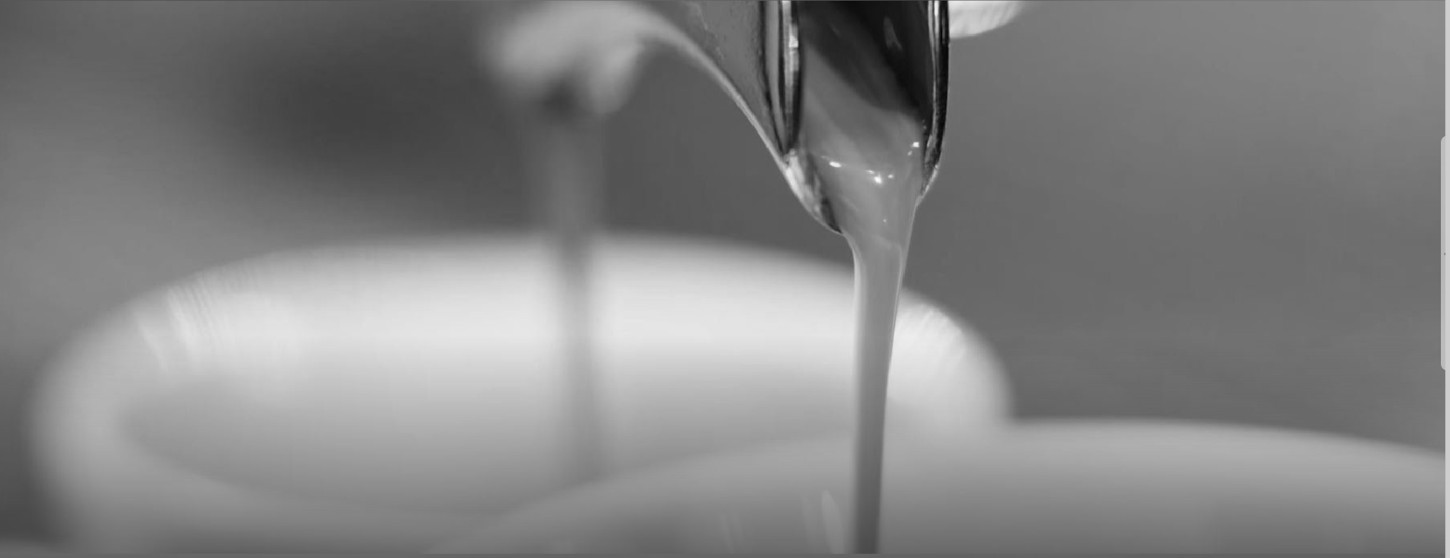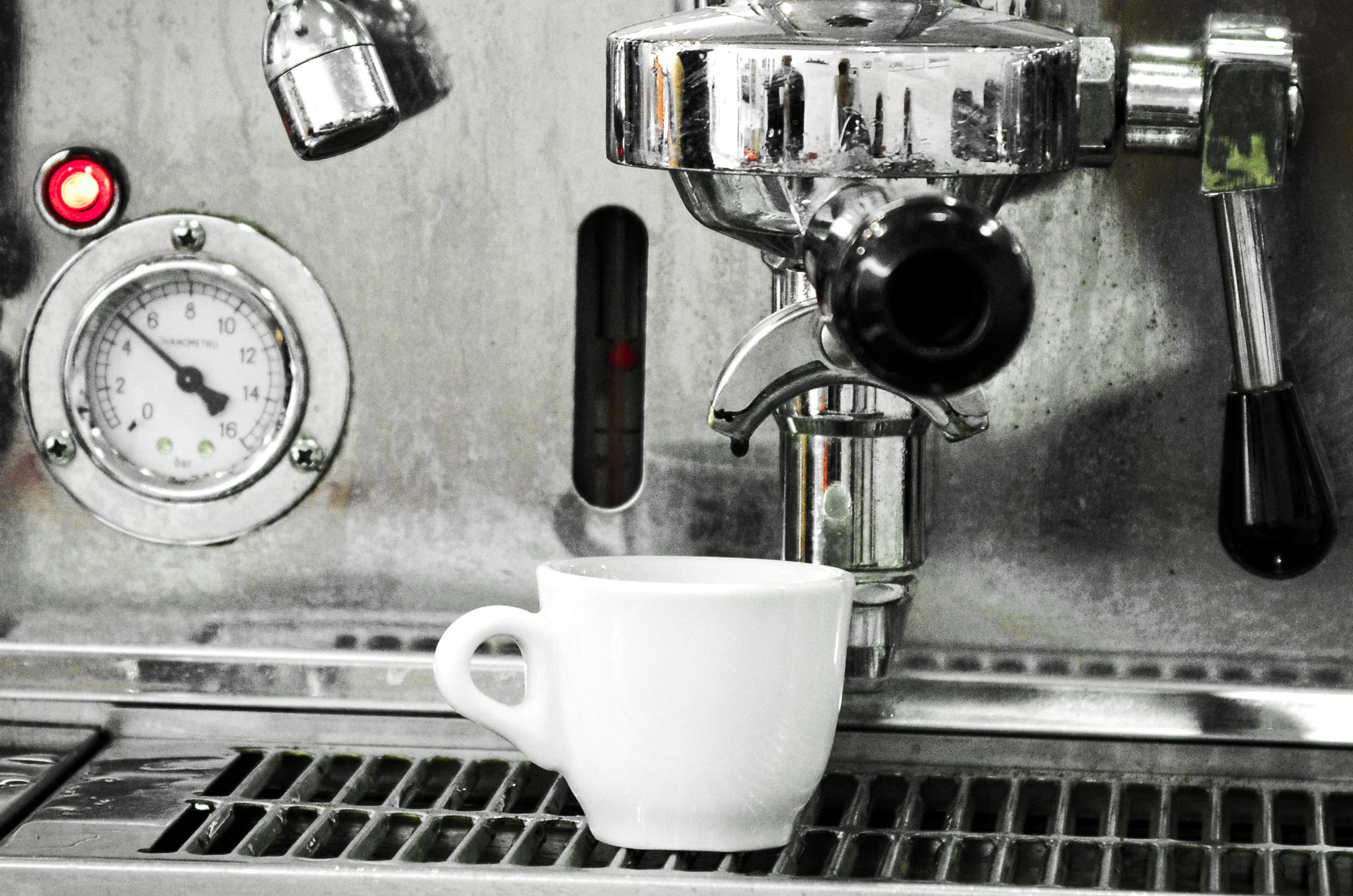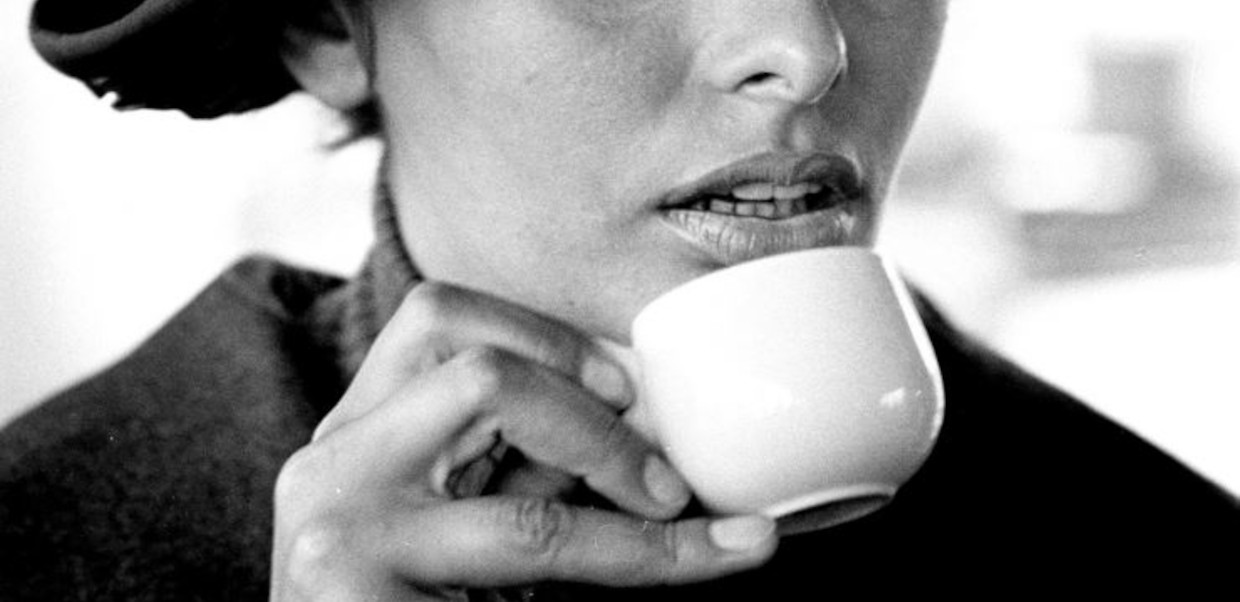Espresso, that we call simply caffè in Italy, can evoke the coziness of the habitual bar or the vibrancy of a bustling market square. We, 59 million Italians from Brennero to Sicily, sip some 30 million espressos a day from a porcelain cup, tazzina, or little glasses, al vetro, with or without a splash of milk, cream or alcohol.
And we enjoy regional coffee specialties that make up the culture of Italian espresso coffee. Also the art of making espresso is celebrated in Italy to ensure each cup has the perfect crema on top.
In this Article
Despite Italy being the home of espresso coffee, no coffee is grown here. The reason Italy is thought to be one of the coffee hot spots of the world is the fact, that the Alfonso Bialetti‘s Moka and Napoletana pot have been developed here, both do not create crema on the coffee, unlike Industrial coffee house machines that use 9 bars of pressure (today’s standard for quality espresso) to produce caffè.
The Moka pot only reaches 1.5 bars of pressure, that is why the black goodness it produces isn’t technically espresso. Nonetheless, the Italian Moka Express and Neapolitan flip stove top brewer from 1900ies still make a reliably delicious dark coffee.
Also the espresso machine is Italian, because it is been invented and perfected here. The beginning of the modern Espresso era begun, when Achille Gaggia used hot water pressure to prepare a delicious espresso, characterized by a soft layer of “crema naturale”.
Italian baristas and roasters are masterful with their techniques as well. Each individual involved in the Italian coffee process takes pride in his work and follow rigorous practices to ensure each blend and cup is as perfect as the last.
Italian coffee tradition has grown to a veritable art form and developed a whole system of rituals and behaviors about espresso and its preparations.
Crema: the distinctive sign of Italian espresso coffee
The gleaming machine behind the marble counter clanks and hisses as the barista tamps the ground coffee into the portafilter, clicks it into place and flicks a switch to shoot near-boiling water through it.
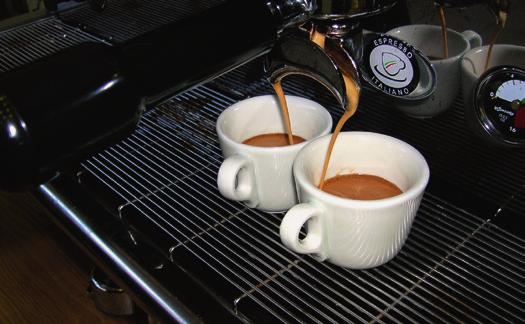
The crema is essential for the espresso coffee, or caffè, spelled café elsewhere in Europe:
7 grams of finely ground coffee meet hot water forced at a pressure of 9 bar for 25-30 seconds, first, we obtain a solution of caffeine, acids, proteins, sugars and other substances followed by a lighter emulsion of impalpable elements composed of coffee particles and CO2 micro-bubbles. These attach themselves to the oils and fats present in the coffee, then rise to the top of the espresso.
This emulsion of microscopic droplets of oils and water is known as espresso crema. It is fine & dense in texture, has discrete thickness, and a hazelnut brown color that covers the surface of the espresso in the cup.
The crema differs from the froth for the absence of bubbles.
While the froth is considered a defect in the cup.
What is crema and its characteristics?
The crema is formed thanks to the combined action of hot water and pressure which, in contact with the fine ground coffee, help release the carbon dioxide stored by the bean during roasting. Pressure is essential for the success of the espresso crema. Therefore, the other extraction methods do not produce crema, like Bialetti and his Moka espresso.
With Gaggia and his crema – making espresso machine, the looks of espresso changed forever. Espresso today is just as much about the presentation as it is about the taste. Part of the reason that crema became a standard of quality in the espresso world is tradition. Much of coffee culture is a continuation of a rich history of caffè in Italy.
What does the appearance of the crema tell about the espresso?
There is a number of factors that affect the color, duration, thickness, and overall appearance of crema and its duration. Some of these include the temperature of the brewing water, the roasting date of the coffee beans, the length of extraction, and the species of coffee beans being used. If coffee is freshly roasted and freshly ground, the crema should last about 2 to 3 minutes.
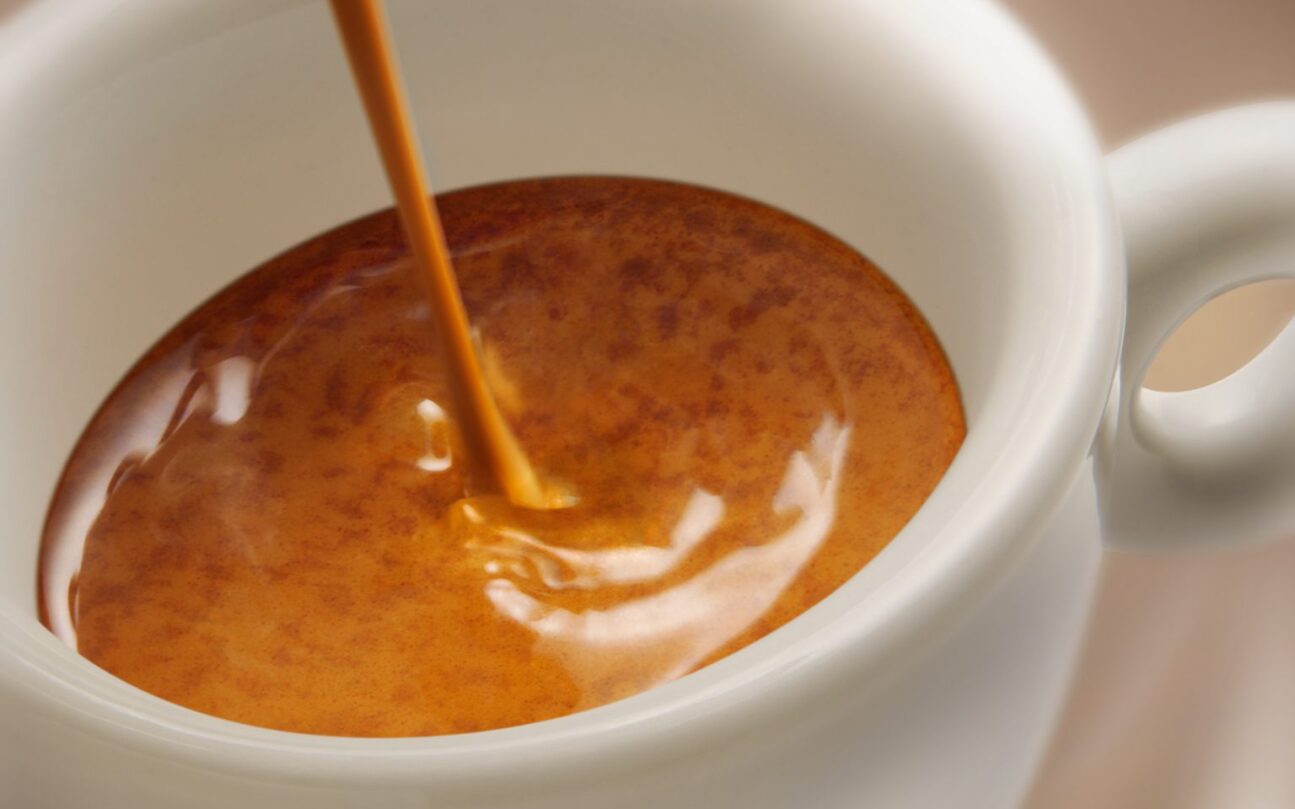
Italian coffee blending
The blend of beans – called miscela – gives each caffè its coffee’s unique character. Only the art of the coffee roaster and the right method of preparation can deliver perfectly thick, crema, a powerful, shot of good Italian coffee.
Robusta give a darker, thicker crema, whereas Arabica a lighter or golden one.

There are two main species from which all the others derive. “Coffea Arabica Linné” or Arabica, the oldest, which represents 70% of world production. “Coffae Canephora Pierre” or Robusta, very different from the previous one, more resistant to heat and disease, which offers a more full-bodied and powerful but less fragrant coffee.
The quantity and consistency of the crema is a consequence of the miscela of Arabica and Robusta coffee and the extraction process that tells many things: it is indicative of the quality of the bean, the roasting, the equipment, and the hand of the barista.
Robusta
It gives the coffee body, structure and creates a coarser, swollen, frothier crema that fades quickly. That is why, we drink the caffé fast. Robustas chemical-physical composition leads to a very dense crema thanks to the type of woody fibers present in the coffee, normally formed by large and thick bubbles, even if in lesser number than Arabica, due to the lower quantity of fats. This gives the crema an orange peel appearance or as if there were sand dunes on the surface of the espresso.
At the same time, however, being “robust”, they are often able to support the weight of sugar crystals for a few seconds. It is as if the crema is made up of 500 large, thick plastic balloons. If you jump on it, the balloons hold you up for a while before exploding under the weight. Obviously, however, given their size, there won’t be many in the cup. This is why when the Robusta crema begins to dissolve (starting from the edge or center of the cup).
The body of this coffee preparation is meant to be very thick if not syrupy with a pleasant aftertaste that is meant to last 15-30 minutes if properly extracted.
Robusta Coffee Beans, some say, deliver a full-bodied taste and a better foam head (the “Crema”).

Arabica
Arabica on the other hand, gives the coffee aroma and produces less crema, but more compact, elasticity with a brighter color than Robusta. Looking at the crema of a good quality Arabica, we notice that its texture is made up of thousands of tiny bubbles, imperceptible to the eye, which however give the surface a bright and reflective look.
The amount of crema a few seconds after brewing, has almost the same thickness as the crema on the espresso made with Robusta, but its consistency, even on the palate, is different. It is as if in the cup there were 2000 very small and thin balloons (like those for making water bombs at the beach). If you jump on them, you will burst 500 and you will end up below, but the remaining number will be enough to reform the surface a layer. Opening the crema with a spoon or putting sugar on it, will shortly break the crema and it will re-form in an elastic way.
The characteristics are so different, especially on the palate, that they give the impression that Robusta makes more crema than Arabica. On the palate Arabica coffee impresses with its fine and fruity notes and is also light and extremely nuanced in terms of flavor.
The color of the crema
Ideally, the crema should be of a hazel color with shimmers of red irregular stripes
There are huge amounts of color variations in crema, and not all of them are bad. Colors will vary as a result of lighter or darker coffee roasts. However, there are other color variances that signal a problem, such as dark rings around the edge of the cup or a crema that is too light.
There is a term that is common in the barista world called “tiger flecking” that refers to inconsistent dark spots in the crema of a well-pulled espresso shot. Tiger flecking likely has to do with the quality of the roast.

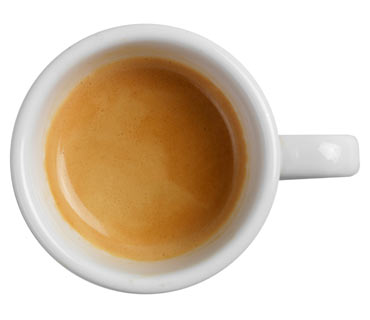
A darker crema is likely a product of over-extraction, or when too much flavor was extracted from the coffee grounds. This could be an issue of too fine of a grind, too much pressure while tamping, or a shot that was pulled too long. An extra-dark crema could also be a sign that the espresso machine is overheated.
Exceptionally light crema is a sign that the espresso was under-extracted, the crema may not last as long. Under-extraction can be a result of grinding, tamping, and brewing and simply means that not enough flavor comes out of the coffee grounds. Lighter crema can also be a result of a cold espresso machine.
And there is more…
Crema made up of a few, large bubbles indicates a coffee that has been brewed too quickly and is probably thin-bodied. Dense, clotted crema indicates a coffee that has been brewed too slowly and may be burned.
What is Espresso? The complex world inside the cup of a good espresso
Espresso is best thought of as neither a type of coffee, nor a form of beverage, but as the outcome of a particular preparation process. Using about fifty beans of roasted coffee, finely ground and putting hot water through them at high pressure, we obtain an elixir, a concentrate where aromatic compounds burst out, to make espresso unique. Moreover, the sensations it offers does not end in the moment it is tasted, but persists.
The three main features that define the art of making espresso are:
- On the spur of the moment: the brew must be prepared just before serving it – express
- In a short time: brewing must be fast
- Under pressure: mechanical energy must be spent within the coffee cake.
Whereas the feature ‘on the spur of the moment’ (or, more colorfully, ‘extemporaneously’) refers not so much to the coffee brewing method as to the ‘espresso lifestyle’, the other two features are strictly related to percolation, says Illy coffee.
Espresso’s authentic formula is clear and basic, its proper execution a matter of training, experience and natural talent.
A jet of hot water at 88°-93°C (190°-200°F) passes under a pressure of nine or more atmospheres through a seven-gram (25 oz) cake-like layer of ground and tamped coffee.
Done right, the result is a concentrate of not more than 30 ml (one oz) of pure sensorial pleasure.

The Italian National Espresso Institute defines Italian Espresso
In 1998 an Italian National Espresso Institute (INEI) was established to evaluate the sensory profile of an “Italian espresso” (espresso italiano), and define the parameters under which this could be produced. According to INEI:
“On sight, Espresso Italiano has a hazel-brown to dark-brown crema – characterized by tawny reflexes – with a very fine texture (absence of large mesh and larger or smaller bubbles).


“The nose reveals an intense scent with notes of flowers, fruits, toasted bread and chocolate. All of these sensations are felt also after swallowing the coffee in the long lasting aroma that remains for several seconds, sometimes even for minutes.
Its taste is round, substantial and velvet-like. Sour and bitter tastes are well balanced and neither one prevails over the other. There is no, or a barely perceptible, astringent taste.“
Historian Jonathan Morris kept the translation offered by INEI although another rendition, he writes, might refer to a long-lasting aftertaste (as opposed to aroma), and a rounded body.
Real Italian espresso – There are many

Espressi in Italy, are changing from bar to bar and from town to town, there are also variations in the cup’s color, aroma, taste and quantity. The significant differences in taste and consumption patterns in the various areas of Italy, in particular between East and West, North and South, are closely linked to the culture, traditions and habits of the people who consume it.
From Brennero to Lampedusa we love our daily dose of caffeine, but it comes in diverse forms.
Unique is, that every city and small town in Italy has their own local roaster, which is why espresso tastes different from region to region.
Identity and coffee preferences — United in diversity
Italian journalist, writer and politician Barzini Luigi (1908 – 1984), most famous for his 1964 book The Italians, delving deeply into the Italian national character and introducing many to Italian life and culture, knows:
“Generalizations about nations and peoples are not easy to make even in the simplest of cases, but to formulate a series of statements that will stand up about a people as varied, as subtle, as complicated as the Italians would appear to be well‐nigh impossible.

On the face of it the Tuscan farmer, the Roman bureaucrat, the Neapolitan tenor, the Venetian fisherman, the Genoese merchant, the Milanese financier – to mention at random only a few types – have neither the same virtues nor vices, neither the same attributes of mind nor the same shortcomings of character.
Italians, for one thing, do not look alike; there is no national physical type. They lack a common history; until a century ago the Italian peninsula was a patchwork of principalities, duchies, republics and colonies of other European powers, each with its own past. Italian has now been imposed over the entire country as a sort of lingua franca, but as anyone who has struggled with the dialects can testify, the inhabitants of Italy do not really even speak the same language.“
Also the language of coffee changes along the Italian peninsula, the type of coffee and the pattern of consumption are associated with the culture of the single regions of Italy. Variations in raw bean composition, in roasting conditions and in the extraction procedures used to prepare coffee brews result in a great diversity of the demitasse of coffee.

Gusto morbido & Gusto forte
Soft, sweet aromatic coffees, what Italians like to call “gusto morbido” coexist with bold strong, slightly bitterish “gusto forte”.
There is a myriad of styles, interpretations, variations on the art of caffé. Not only from north to south, but also from east to west. East Italy has espressos that tend to be darker, toasted in aroma, bitter and chocolaty; while in the West they show a more marked acidity and a freshness that is accompanied by more marked floral and fruity notes.
In the North of Italy, coffee tends to be more delicate and thus with a higher percentage of Arabica (usually Arabica 80%, Robusta 20%), with light, fruity, floral profiles and high acidity. Northern Italy standards use an Arabica and Robusta blend to create flavor notes that dominate with caramel, vanilla, chocolate, and nuts.
In the South stronger coffee is expected, therefore with a higher percentage of Robusta. Robusta drinkers look for the element of smokey, slightly bitter caramel, which is the natural coffee sugars being caramelized in the high heat of a dark roast. Robusta beans also have around twice the caffeine content of Arabica and more of the chlorogenic antioxidants responsible for many of the coffee’s health benefits. Robusta Coffee Beans, that deliver a full-bodied taste and a better foam head (the “Crema”) are expected in a good espresso or Napoletana.
In central Italy, a golden 50/50 rule is customary. The roast degree also changes accordingly, with North preferring a lighter one and the southerners a darker one.
The recent trends of Single origin Arabica beans, with light, fruity, floral profiles and high acidity are more and more common.
There are over 800 roasters in Italy catering for a widely differentiated market. We Italians have very strong and historically rooted regional culinary traditions, and coffee is no exception.

Sugar is optional and largely dependent on the roast, the volume of bitterness in the coffee and the individual taste.
Furthermore, the extraction in the cup will be longer in the north, while in the south only a true ristretto will be accepted, with sugar floating on the thick crema. Sugar should stay a few seconds before sinking on a perfect espresso.
Even cappuccinos are a northerly preference and nearly absent from Rome downwards.
The 4 M of espresso – le quattro M del caffè
Several Espresso coffee preparation factors are precisely defined to obtain the desired chemical compounds and caffeine concentration in espresso.
Illy Andrea
According to the Italian National Espresso Institute (INEI) the four “Ms” create a rich and elegant drink, with a light, crema that floats on top of the coffee. The 4 Ms act in together to produce the perfect espresso.
Macchina – espresso machine
Macinazione – the proper way to grind coffee
Miscela – the coffee blend and
Mano – are the skilled hands of the barista
With the Semi-automatic espresso machines, for the first time, espresso was now being produced under a relatively constant 9 bars of pressure, while the barman: chooses the blend (in some cases they even roast the coffee beans themselves) utilize the grinder to adjust the coffee’s resistance to the water flow, and controlled the length of the extraction through the switch on the machine, thereby enabling him to adjust the volume and body of the espresso.

Over more than a century, Espresso machines have been vastly improved, with sensors, automatic electricity, microprocessors, etc. As for coffee, the role of design, science, and technology is not everything. Espresso machines are still hand operated and espresso the product of the artistry of the barman. The barista’s talent and professional skills are just as important as the blends’ quality and the grinder’s efficiency.
The tazzina, the tiny cup needs to be hot. It is heated on top of the espresso machine, or kept submerged in boiling water. The belief is that a heated cup enhances the flavor of the coffee and allows it to come through clean and clear.
The 5 M of espresso – le cinque M del caffè
Miscela – blend
Macchina – the coffee machine
Macinino – the grinder
Manutenzione – machine maintenance
Mano – the skill of the barista.
Machine maintenance

Manutenzione, the maintenance is crucial, before actually pouring out the espresso, the barista must make certain that the machine is clean and functioning properly, checking the pressure of the water, its temperature and ensuring that it’s temperature remains constant. The aromatic volatile oils from the coffee beans can taste rancid if they are not washed away between brewing.
Popular Italian wisdom holds, that the best coffee is served at gas stations along the highways, at airports and train stations, simply because the quality of espresso is best when produced by a machine that churns out hundreds of coffees each day.
And the hand of the experienced barista makes all the magic happen.
The coffee menu – Habits of Italians at the coffee bar
In Italy the classic espresso at the bar emphasizes simplicity: perfect short espresso and a handful of exquisitely modulated combinations of coffee and milk. Espresso cuisine, emphasizes smaller servings of heavier-bodied, richer coffee, brewed on demand.
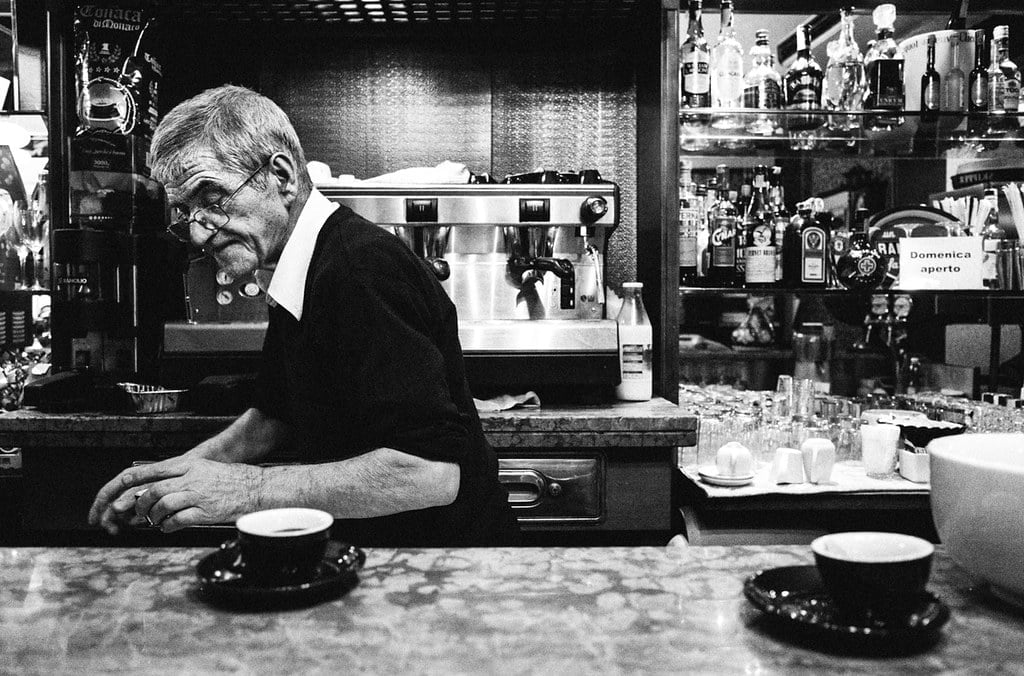
“un caffè, per favore”
,”a coffee/espresso please”, and after you hand your receipt to the barista, you’ll receive a short, strong black shot often accompanied by a small glass of water for palate cleansing.
Italian Caffé al bar
The variations on Italian caffè are as many, as there are people in front of the counter: ristretto or corto, short, long, double; served in a high, tiny cup, large cup, glass, decaf or hag, hot macchiato, cold macchiato, lukewarm, with milk aside, with soy milk, almond milk, with cream and there is regional coffee specialties marocchino, con la mosca, and many more…
North Europeans and Americans emphasize on the bottomless cup: large, repeated servings of usually brisk-tasting, light-bodied coffees prepared by the filter method, often taken without milk or sweetener.
Caffè KHa-ff-Ee – is espresso ESS-pre-SSo – in Italy. Espresso crema (the word has passed into English), fine and dense in texture and a hazelnut brown color, has to cover the surface of the coffee in the cup, the tazzaina ta-ZZ-II-na.
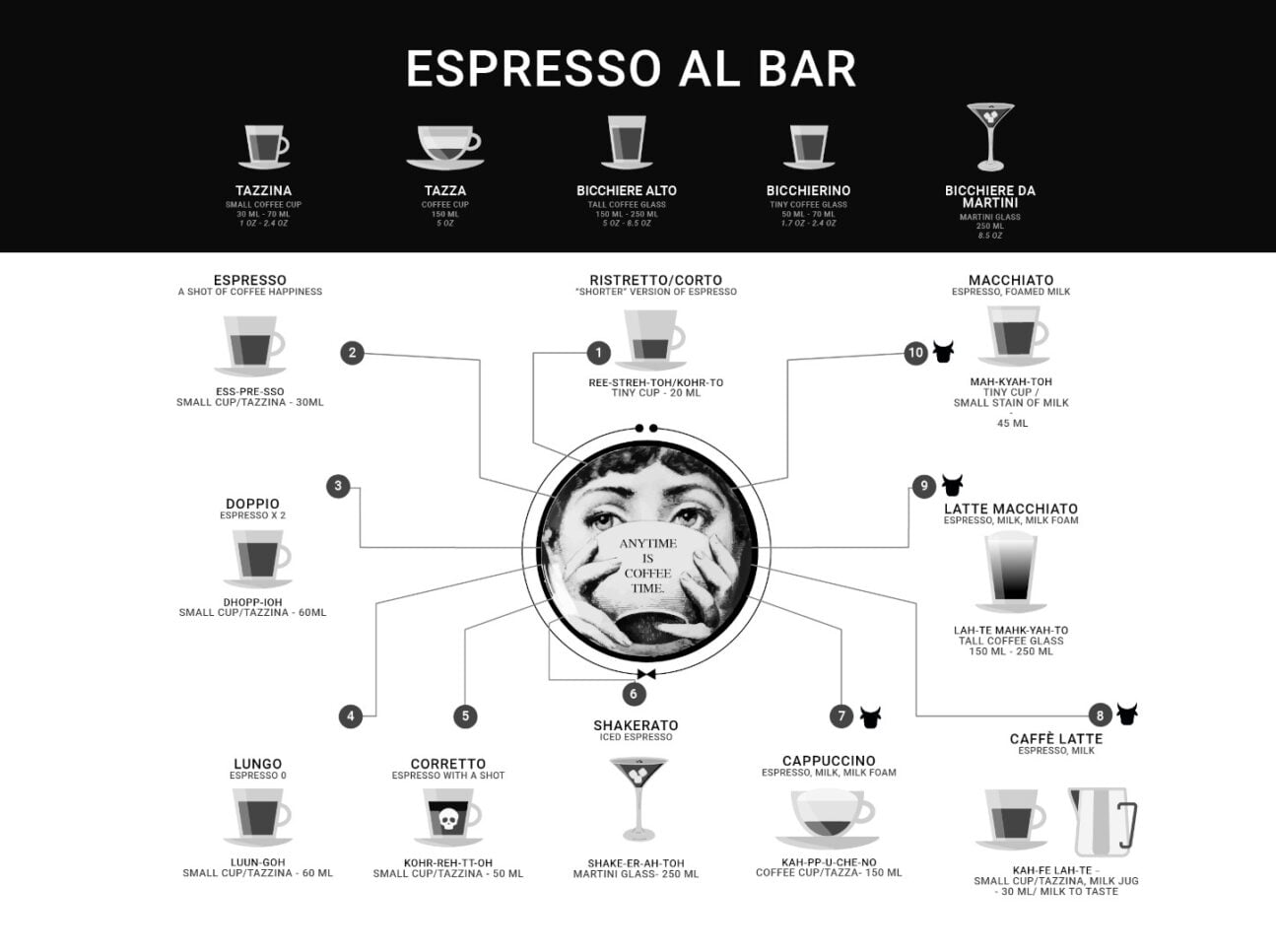
Menu: Caffè al BAR
- Ristretto ree-STREH-toh or corto Kohr-to – meaning a, “shorter” version of an espresso, using less water
- Caffè KHa-ff-Ee – a tiny shot of espresso – ESS-pre-SSo – with a unique Italian palate that comes down to not being over-watered or over-roasted. The espresso crema (the word has passed into English), fine and dense in texture and a hazelnut brown color, has to cover the surface of the espresso in the cup, a tazzaina ta-ZZ-II-na.
- Doppio DHOPP-ioh – meaning “double,” extracted using double the amount of ground coffee in a larger-sized portafilter basket
- Lungo LUUN-goh – meaning a “longer” version of an espresso, using more water, the espresso is filling the tiny cup nearly to the rim
- Caffè corretto – KohR-Reh-TT-oh – meaning “correct,” a shot of liquor is ether served with a shot of espresso or finds his way into the tiny cup [in the morning..sic!]
- Shakerato Shake-er-Ah-to – a fresh espresso mixed with sugar and ice until it froths as it’s poured into a chilled glass
- Cappuccino Kah-PP-u-CHE-no – frothy milk with a shot of espresso, 1/3 of coffee, 1/3 steamed milk and 1/3 of foam, served in a tazza ta-ZZ-a a cappuccino cup
- Caffè e latte KHa-ff-Ee e La-TT-e is an espresso, with steamed milk served separately in a small jug. International friends of ours told us, that ordering latte in Italy got them a glass of hot steamed milk – no coffee or coffee art for miles around.
- Latte macchiato Lah-TTe mahk-YAH-tho – steamed milk “stained” with espresso and an additional layer of frothed milk on top, served in a tall glass.
- Or the golden midway, il caffè Macchiato Mah-KYAH-toh – an espresso stained with foamed milk.
In the Italy of coffee, however, you just need to change city to find variations in color and aroma, taste and quantity in the cup.
Italian regional Coffee specialties
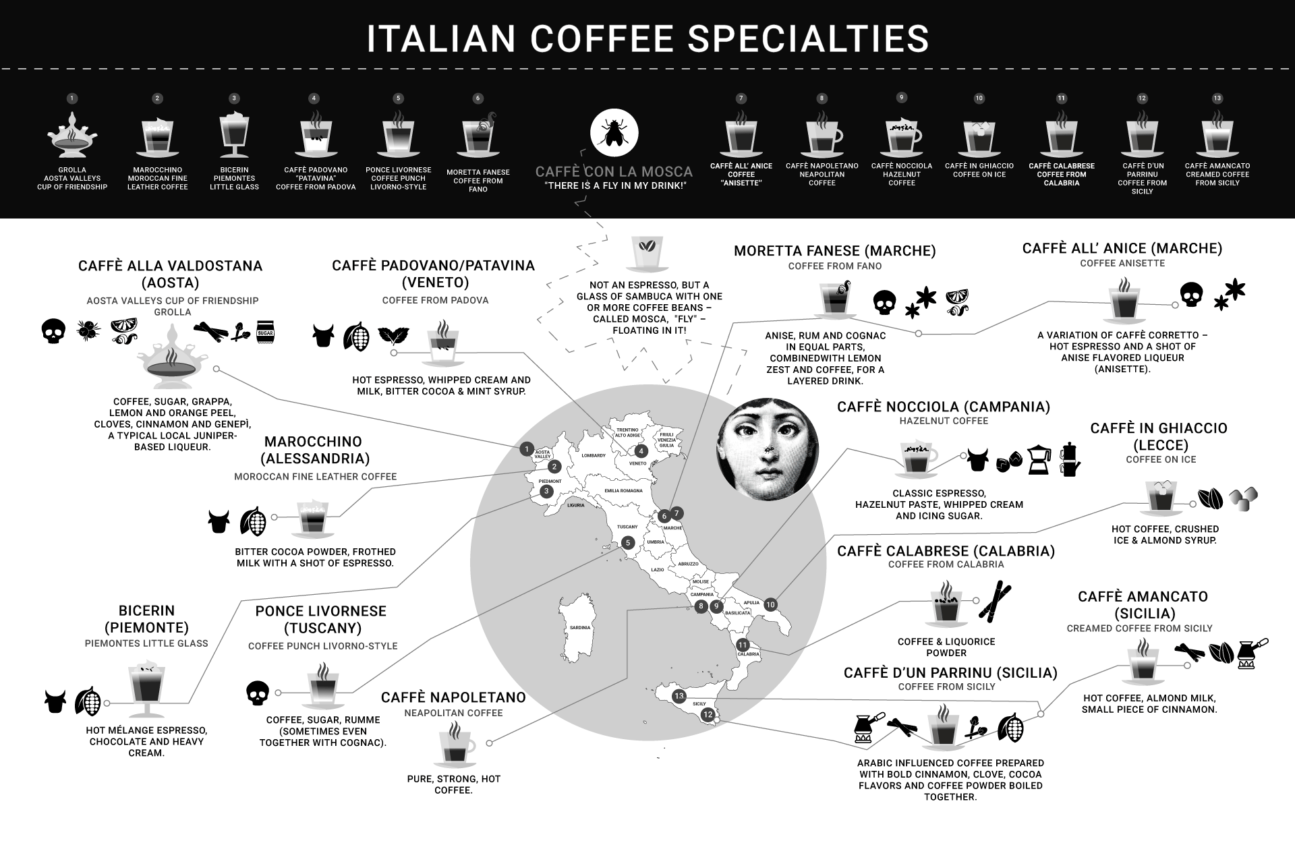

Regional coffee diversity in Italy
Lungo or ristretto, espresso, sweet or bitter, with or without sugar, in glass or tiny ceramic cup, and shaken with ice. While remaining a common ritual, coffee is deliciously diverse combined with regional flavors and Italian traditions from east to west and north to south along the Italian peninsula. Unique is, that every city and small town of the bel paese has their own local roaster, which is why espresso tastes different from region to region.
1. Caffè alla valdostana (Aosta) – Aosta Valleys cup of friendship
The cup of friendship, is a bowl made of walnut or maple wood with special spouts from which dinner companions sip the beverage in company. This special container was born in the 18th century to keep people warm during winter, it is made with coffee, sugar, grappa, lemon and orange peel, cloves, cinnamon and Genepì, a typical local juniper-based liqueur.
2. Marocchino (Alessandria) – Moroccan fine leather coffee
As the evolution of the Piedmontese bicerin, the Marocchino was born in Alessandria in the first half of the 20th century, more precisely at Bar Carpano, which was located in front of the historic Italian hat factory Borsalino. Inside the hats there was a strip of fine leather called Marocchino, once used for binding books: the name of the coffee beverage was chosen for the reference to the dark colour of the high quality leather.
The Marocchino is served upside-down – bitter cocoa powder is covered with frothed milk, then spiked with a shot of espresso. The drink is served in transparent glass cups that allow to admire the different layers.
3. Bicerin (Piemonte) – Piedmontes little glass
The name recalls the small glasses or a glass goblets in which Bicerin in served. This traditional Piedmontese hot mélange of freshly brewed espresso, chocolate and heavy cream, inherits the 18th-century recipe of Bavareisa. The recipe is a secret, guarded by the historic Al Bicerin coffee bar in the center of Turin (since 1763) . At first, they served the ingredients separately. Then, they combined them into 3 types of drinks:
- pur e fiur (like cappuccino),
- pur e barba (coffee and chocolate), and
- ‘n poc’d tut (a little bit of everything). It is enjoyed without stirring, to enjoy the layered ingredients and to appreciate the different densities and temperatures in the glass.
4. Caffè Padovano or Patavina (Veneto) – Coffee from Padova
Many people like foamy cream in their espresso: this is not the only secret of Padua-style coffee, born in the 19th century at Pedrocchi coffee, a reference point for the intellectuals of the time. This hot espresso comes with whipped cream and milk, a sprinkling of bitter cocoa and a dash of mint syrup.
5. Ponce Livornese (Tuscany) – Coffee punch Livorno-style
In Livorno alcohol, spices and coffee are mixed together in ponce. Inspired by British punch made with tea, sugar, brandy, lemon and cinnamon, the Tuscany variation replaces tea with coffee enriched with rumme, a local alcohol, mixed with sugar, caramel and sometimes adding rum essence.
The recipe was born in the early 18th century, thanks to the presence of British communities on the Tuscan coast. Ponce is made with coffee, sugar, rumme (sometimes even together with cognac), boiled together and served hot.
6. Moretta Fanese (Marche) – Coffee from Fano
Moretta Fanese is a late 19th century recipe with maritime origins, created to find comfort during the coldest days at sea. Sailors would add coffee to the leftover liqueu bottles. Anise, rum and cognac in equal parts are heated and combined, together with the lemon zest and coffee, for a layered drink, with an extremely sweet and invigorating taste.
7. Caffè all anice (Marche) – coffee anisette
Caffè is a variation of caffè corretto – espresso with a shot of liquor. In this case anisette, an anise flavored liqueur is used.
8. Caffè napoletano – Neapolitan coffee
Strong, soft, hot: Neapolitan coffee, a symbol of the city together with Mt Vesuvius, the sun and pizza. Many Neapolitans say it’s the water from the Serino springs that gives the beverage more flavour, but that is only one story.
The ritual makes the difference. Comm’ cazz’ coce – espresso is served very hot, piping hot, and baristas often recommend creating a mustache of coffee on the edge of the cup, to mitigate the high temperature. However, it’s “mandatory” to drink a glass of water to cleanse the mouth and prepare the palate before touching the hot tazzina (tiny hot coffee cup).
What really characterizes the coffee taste are the robusta coffee beans, which give body to the espresso, facilitating the formation of the much loved naturally forming crema top.
9. Caffè nocciola (Campania) – Hazelnut Coffee
Born in the 1990s during the period of great cultural and social recovery in Naples, it is easily prepared with the classic espresso or made at home with the Napolitana or Moka. All you need is to mix hazelnut paste with whipped cream and icing sugar.
10. Caffè in ghiaccio (Lecce) – Coffee on ice
The history of coffee on ice of Lecce tradition is the perfect chilled beverage for the summer. It was invented by Antonio Quarta, who more then 70 years ago was involved in distributing ice in the city. At that time, no one had a refrigerator in the house, and leather cells were used to store food.
This means everyone went to his bar, previously called La Casa del Caffè and now known as Avio Bar, to pick up the ice. The real Lecce coffee was made with pickaxed ice, reduced into coarse shards. Another fundamental ingredient is almond syrup, which makes the coffee creamy.
11. Caffè Calabrese (Calabria) – Coffee from Calabria
Coffee and licorice are the main ingredients: delicious and energetic. It is made adding liquorice powder, a typical plant of Southern Italy with many beneficial properties, combined with coffee, brandy or Cognac and a teaspoon of sugar. Aromatic and tasty, Calabrian coffee is a perfect natural digestive.
12. Caffè d’un Parrinu (Sicilia)
Caffè d’un Parrinu is an Arabic influenced coffee treat prepared mostly at home in the Moka or Napoletana. This coffee boasts bold cinnamon, clove, cocoa flavors and coffee powder boiled together.
13. Caffè amancato (Sicilia) – cream coffee
A typical drink from Trapani, caffè amancato has very distant origins and consists of the preparation of a traditional coffee with a moka using almond milk instead of water. Often a small piece of cinnamon is added. At breakfast or at the end of a meal, it is a sweet cuddle to accompany every break.
14. Caffè con la mosca – coffee with a fly (not a coffee)
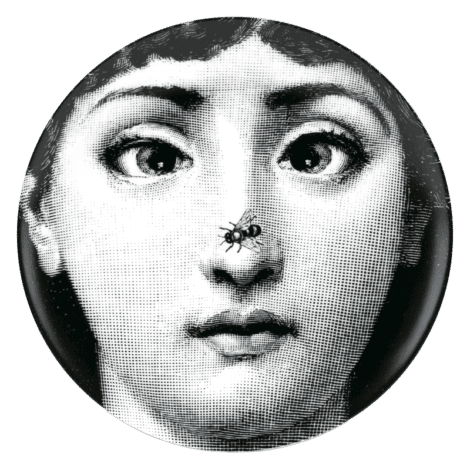
It is not an espresso, but a glass of Sambuca served with one or more coffee beans – called mosca, “fly” – floating in it, which is still worth mentioning.
There are many anecdotes about the origin of this tradition, but the most curious concerns Federico Fellini, Marcello Mastroianni, Anita Ekberg and Walter Chiari during the filming of “La dolce vita.” The actors used to spend their break in a coffee bar on Rome’s Via Veneto and, according to popular belief, one day as a joke one of them dropped a coffee bean into a glass of Sambuca, shouting “There is a fly in my drink!”
Then, there’s other coffee specialties, like Granita di Caffé – a frozen mix of coffee, sugar and water usually served with a big dollop of whipped cream on top – and Affogato – an espresso with vanilla ice cream and whipped cream – which is how we Italians turned our beloved espresso into a sweet delicacy.
Italy the land of great espresso…

Don’t allow yourself to be lulled into a sense of false security regarding all the wonderful coffee you get in Italy. There are some truly awful puddle waters out there. You could be the next victim.
Coffee is essentially a matter of personal taste and heritage – enjoy your espresso – whatever your preferences.
~ ○ ~
Keep exploring:
Works Cited & Multimedia Sources
The history of coffee is an extraordinary study. If you would like to learn more about it, I heartily recommend the book, All About Coffee, by William Ukers. Written in 1928, it will delight you with detail.
- it.wikiquote.org (https://it.m.wikiquote.org/wiki/Voci_e_gridi_di_venditori_napoletani)
Voci e gridi di venditori napoletani - http://90905.homepagemodules.de/t155f59-Cappuccino-Kapuziner-Melange-oder-wie-jetzt.html
- https://en.wikipedia.org/wiki/Caff%C3%A8_sospeso
- Allegra World Coffee Portal www.worldcoffeeportal.com
- Artusi Pellegrino. Science in the Kitchen and the Art of Eating Well, transl. Murtha Baca and Stephen Sartarelli. 2003.
- Biderman Bob. A people’s history of coffee and cafés. 2013.
- Café Culture Magazine www.cafeculturemagazine.co.uk
- Carosello Bialetti: la caffettiera diventa mito https://www.famigliacristiana.it/video/carosello-bialetti-moka-mito.aspx
- Cociancich Maurizio. Storia dell’ espresso nell’Italia e nel mondo. 100% Espresso Italiano. 2008.
- Comunicaffe International www.comunicaffe.com
- Davids Kenneth. Espresso Ultimate Coffee. 2001.
- De Crescenzo Luciano. Caffè sospeso. Saggezza quotidiana in piccoli sorsi. 2010.
- De Crescenzo. Luciano. Il caffè sospeso.
- Eco Umberto. “La Cuccuma maledetta” in Agostino Narizzano, Caffè: Altre cose semplici. 1989.
- Global Coffee Report www.gcrmag.com
- Gusman Alessandro. Antropologia dell’olfatto. 2004.
- Hippolyte Taine, wrote in, Italy: Florence and Venice, trans J. Durand. 1869.
- https://www.italienaren.org/tradizioni-italiane-caffe-in-ginocchio/
- http://www.archiviograficaitaliana.com/project/322/illycaff
- http://www.baristo.university/userfiles/PDF/INEI-M60-ENG-Public-Regulation-EICH-v4-1.pdf
- http://www.coffeetasters.org/newsletter/en/index.php/category/a-baristas-life/
- http://www.coffeetasters.org/newsletter/it/index.php/il-galateo-del-caffe/01524/
- http://www.culturaacolori.it/fascismo-contro-le-parole-straniere/
- http://www.espressoitaliano.org/en/The-Certified-Italian-Espresso.html
- http://www.inei.coffee/en/Welcome.html
- https://archiviostorico.fondazionefiera.it/entita/585-bialetti-industrie
- https://bialettistory.com/
- https://cdn.intechopen.com/pdfs/55623.pdf Severini Carla. Derossi Antonio. Ricci Ilde. Fiore Anna Giuseppina. Caporizzi Rossella. How Much Caffeine in Coffee Cup? Effects of Processing Operations, Extraction Methods and Variables
- https://en.wikipedia.org/wiki/Drip_coffee#Cafeti%C3%A8re_du_Belloy
- https://en.wikipedia.org/wiki/ISSpresso
- https://en.wikipedia.org/wiki/Italian_meal_structure
- https://en.wikipedia.org/wiki/Neapolitan_flip_coffee_pot
- https://hal.science/hal-00618977/document
- https://hub.jhu.edu/magazine/2023/spring/jonathan-morris-coffee-expert/
- https://ineedcoffee.com/the-story-of-the-bialetti-moka-express/
- https://it.wikipedia.org/wiki/Caff%C3%A8
- https://it.wikipedia.org/wiki/Caff%C3%A8#Risvolti_etici_e_sociali
- https://it.wikipedia.org/wiki/Napoletana
- https://italofonia.info/la-politica-linguistica-del-fascismo-e-la-guerra-ai-barbarismi/
- https://italysegreta.com/italian-hospitality-the-invite/
- https://library.ucdavis.edu/wp-content/uploads/2022/06/LangPrize-2017-ElizabethChan-Project.pdf
- https://memoriediangelina.com/2009/08/11/italian-food-culture-a-primer/
- https://mostre.cab.unipd.it/marsili/en/130/the-everyday-eighteenth-century
- https://napoliparlando.altervista.org/cuccumella-la-caffettiera-napoletana/
- https://specialcoffeeitaly.com/barista-espresso-coffee-machine/
- https://specialcoffeeitaly.com/italian-breakfast-cappuccino-cornetto/?_gl=1*1gjfoya*_ga*OTE0MDM2ODM5LjE2OTMzNjE5OTg.*_ga_2HTE5ZB0JS*MTY5MzM2MTk5Ny4xLjEuMTY5MzM2Mjk0NS4wLjAuMA../
- https://specialcoffeeitaly.com/what-came-first-the-italian-bar-or-coffee/
- https://themokasound.com/
- https://uwyoextension.org/uwnutrition/newsletters/understanding-different-coffee-roasts/
- https://www.adir.unifi.it/rivista/1999/lenzi/cap2.htm
- https://www.bialetti.co.nz/blogs/making-great-coffee/using-bialetti-coffee-makers
- https://www.bialetti.com/ee_au/our-history?___store=ee_au&___from_store=ee_en
- https://www.bialetti.com/it_en/inspiration/post/ground-coffee-for-moka-should-never-be-pressed
- https://www.brepolsonline.net/doi/pdf/10.1484/J.FOOD.1.102222
- https://www.coffeeartproject.com/TheCollection/Amsterdam/2014.aspx
- https://www.coffeeartproject.com/TheCollection/Amsterdam/2014.aspx
- https://www.coffeeartproject.com/TheCollection/Milan/2013/Gallery/Other/Amalia-Chieco
- https://www.coffeeartproject.com/TheCollection/NewYork/2016.aspx
- https://www.coffeeartproject.com/TheCollection/NewYork/2017.aspx
- https://www.coffeeartproject.com/TheCollection/NewYork/2018.aspx
- https://www.coffeeartproject.com/TheCollection/NewYork/2019.aspx
- https://www.coffeeresearch.org/science/aromamain.htm
- https://www.coffeereview.com/coffee-reference/from-crop-to-cup/serving/milk-and-sugar/
- https://www.comitcaf.it/
- https://www.ecf-coffee.org/wp-content/uploads/2023/05/European-Coffee-Report-2022-2023.pdf
- https://www.espressoitalianotradizionale.it/
- https://www.euronews.com/culture/2022/02/15/the-italian-espresso-makes-a-bid-for-unesco-immortality
- https://www.faema.com/int-en/product/E61/A1352IILI999A/e61-legend
- https://www.finestresullarte.info/en/works-and-artists/the-bialetti-moka-the-ultimate-romantic-design-object
- https://www.finestresullarte.info/opere-e-artisti/moka-bialetti-oggetto-design-ultimi-romantici
- https://www.freemalaysiatoday.com/category/leisure/food/2022/02/15/italy-woos-unesco-with-magic-coffee-ritual/
- https://www.gaggia.com/legacy/
- https://www.gamberorossointernational.com/news/coffee-10-false-myths-to-dispel-on-the-beverage-most-loved-by-italians/
- https://www.gcrmag.com/calls-to-review-price-structure-of-italian-espresso/
- https://www.granaidellamemoria.it/index.php/it/archivi/caffe-espresso-italiano-tradizionale
- https://www.illy.com/en-us/coffee/coffee-preparation/how-to-make-moka-coffee
- https://www.illy.com/en-us/coffee/coffee-preparation/how-to-use-neapolitan-coffee-maker
- https://www.ilpost.it/2011/06/08/itabolario-bar-1897/
- https://www.itstuscany.com/en/bar-where-the-word-comes-from/“Cafe Hawelka”, John A. Irvin
- https://www.lastampa.it/verbano-cusio-ossola/2016/02/17/news/le-ceneri-di-renato-bialetti-nella-sua-moka-con-i-baffi-1.36565348/
- https://www.lavazza.com/en/coffee-secrets/neapolitan-coffee-maker
- https://www.lavazzausa.com/en/recipes-and-coffee-hacks/making-espresso-at-home
- https://www.linkedin.com/pulse/third-wave-coffee-meets-tradition-neapolitan-maker-bruno-lopez
- https://www.mumac.it/we-love-coffee-en/be-our-guest-en/progettazione-e-rito/?lang=en
- https://www.quartacaffe.com/images/pdf/carta-dei-valori.pdf
- https://www.repubblica.it/il-gusto/2021/07/26/news/caffe_il_piu_clamoroso_equivoco_gastronomico_d_italia-311835974/
- https://www.taccuinigastrosofici.it/ita/news/contemporanea/semiotica-alimentare/print/Pop-cibo-di-sostanza-e-circostanza.html
- https://www.thehistoryoflondon.co.uk/coffee-houses/
- https://www.wien.gv.at/english/culture-history/viennese-coffee-culture.html
- Illy Andrea. Viani Rinantonio. Furio Suggi Liverani. Espresso Coffee. The Science of Quality. 2005.
- International Coffee Organization www.ico.org
- Kerr Gordon. A Short History of Coffee. 2021.
- La cremina per il caffè: come farla bene. https://www.lacucinaitaliana.it/news/cucina/come-fare-la-cremina-del-caffe/
- Allen Lee Stewart. Devil’s Cup. A History of the World According to Coffee. 1999.
- Leonetto Cappiello – Wikipedia page on the creator of the 1922 poster La Victoria Aduino.
- Markman Ellis. The Coffee House. A Cultural History. 2005.
- Mennell Stephen. All Manners of Food. Eating and Taste in England and France. 1996.
- Montanari Massimo. Il riposo della polpetta e altre storie intorno al cibo. 2011.
- Montanari Massimo. Il sugo della storia. 2018.
- Morris Jonathan. A Short History of Espresso in Italy and the World. Storia dell’espresso nell’Italia e nel mondo. In M. Cociancich. 100% Espresso Italiano. 2008.
- Morris Jonathan. Coffee: A Global History. 2019.
- Morris Jonathan. Making Italian Espresso, Making Espresso Italian.
- National Coffee Association www.ncausa.org
- Pazzaglia Riccardo. Odore di Caffe’. 1999.
- Pendergrast Mark. Uncommon Grounds. The History of Coffee and How It Transformed Our World. 2019.
- Perfect Daily Grind www.perfectdailygrind.com
- Scaffidi Abbate Mario. I gloriosi Caffè storici d’Italia. Fra storia, politica, arte, letteratura, costume, patriottismo e libertà. 2014.
- Schnapp Jeffrey. The Romance of Caffeine and Aluminum. Critical Inquiry. 2001.
- Sibal Vatika. Food: Identity of culture and religion. 2018.
- Specialty Coffee Association www.sca.coffee
- Spieler Marlena. A Taste of Naples. 2018.
- Tea and Coffee Trade Journal www.teaandcoffee.net
- The Long History of the Espresso Machine. www.smithsonianmag.com
- The Pleasures and Pains of Coffee by Honore de Balzac
- The relaxation ritual https://themokasound.com/
- Tucker, Catherine M. Coffee Culture: Local Experiences, Global Commensality, Society and Cuture 2011.
- World Coffee Research www.worldcoffeeresearch.org
